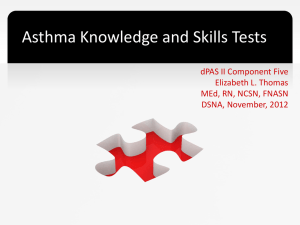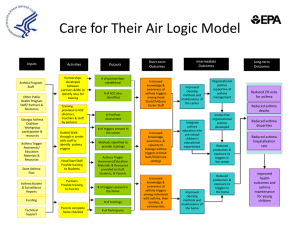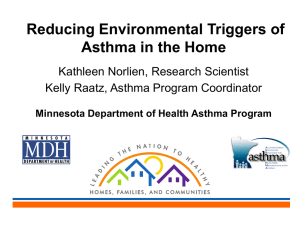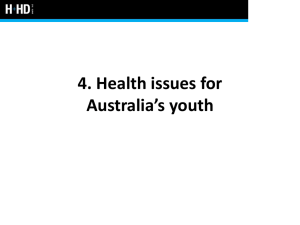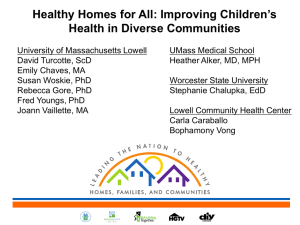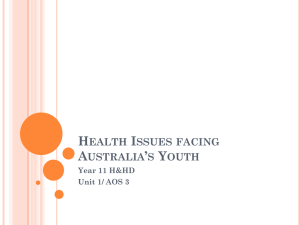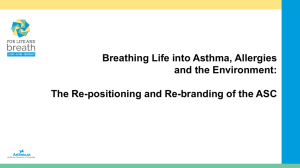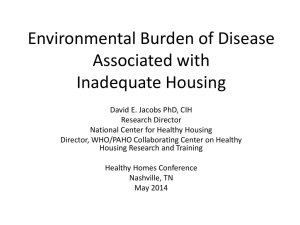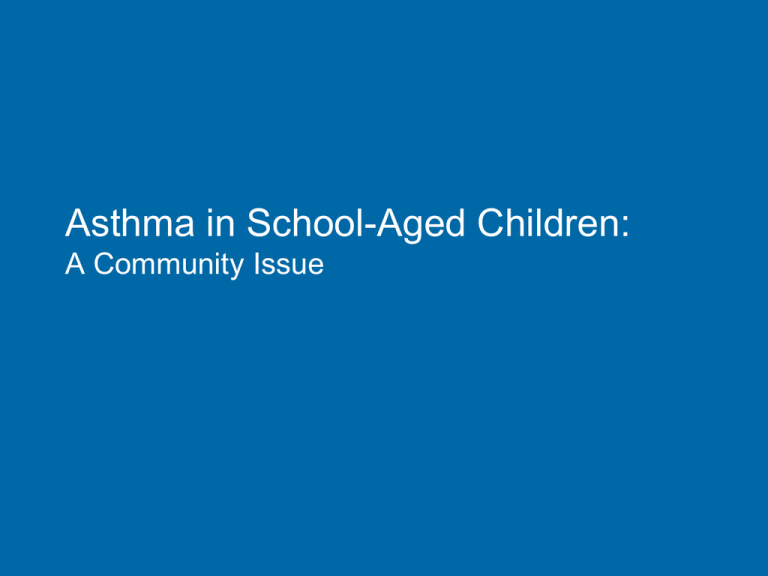
Asthma in School-Aged Children:
A Community Issue
Table of Contents
Chapter 1.
The Prevalence and Burden of Asthma
in School-Aged Children
Chapter 2.
What Is Asthma?
Chapter 3.
Asthma Control
Chapter 4.
Current Gaps in Managing Asthma in the
School Setting
Chapter 5.
What Can I Do?
Chapter 1. The Prevalence
and Burden of Asthma in
School-Aged Children
Objectives
Questions we’ll address in this section:
• Which children have asthma?
• What is the burden of asthma on:
– The student?
– The parent?
– Society?
Asthma in School-Aged Children
Asthma
• Over 6 million US children with asthma (2005)1
• Most common chronic illness in children2
• 63,000 people miss school or work due to asthma
• One of the leading causes of hospitalizations of children2
– 198,000 hospitalizations in 20041
• One of the leading causes of school absenteeism2
– 12.8 million lost school days in 20031
1. Centers for Disease Control and Prevention. cdc.gov/nchs/products/pubs/pubd/hestats/ashtma03-05/asthma03-05.htm. Accessed February 25, 2009.
2. Asthma and Allergy Foundation of America. aafa.org/display.cfm?id=8&sub=42. Accessed February 25, 2009.
Asthma in MS
• 1 in every 14 adults have asthma
– More women than men (8% v. 5%).
• 1 in every 10 children have asthma
– About 2 per classroom.
– More African American children than other
children
(13% v. 8%).
– More boys than girls (12% v. 8%).
Specific Populations With Asthma
• Any child can have asthma.
• It is more common in boys
throughout childhood.1
• It is more commonly diagnosed in
Puerto Rican and African
American children.1
• Lower-income and inner-city
children appear to be at increased
risk of hospitalizations, emergency
department visits, and deaths due
to asthma.2,3
1. Akinbami LJ. cdc.gov/nchs/data/ad/ad381.pdf. Accessed February 25, 2009.
2. Eisner MD et al. Respir Res. 2001;2:53–60.
3. Centers for Disease Control and Prevention dc.gov/healthyyouth/asthma/pdf/asthma.pdf. Accessed February 25, 2009.
Burden on Children
• Children with asthma:
– May not be able to participate
fully in extracurricular activities
– May avoid sports or play
– May not be able to sleep through
the night without coughing
– May not feel comfortable visiting
certain friends or relatives
– May miss school days
O’Connell EJ. Allergy. 2004;59:7–11.
Burden on Parents
• Parents of a child with asthma:
– May have to leave work to
pick up a child who’s having
severe symptoms
– Fear their child may have an
attack while not with them
– May feel overwhelmed trying to
understand the role of different
medications and the schedule for
taking each one
– May experience reduced
productivity during the day after
caring for their child at night
Burden on Society and the Community
• Health care use due to childhood asthma1
– Doctor visits have doubled since 1980.
– Health care use is highest among the youngest children.
• Estimated cost of treating asthma in children, according to Weiss,
is $3.2 billion per year.2
• Nearly half of all families with an asthmatic child report that they
do not have enough money to pay for their health care.3
• There are indirect costs due to lost work days.4
1. Akinbami LJ. cdc.gov/nchs/data/ad/ad381.pdf. Accessed February 25, 2009.
2. Weiss KB. J Allergy Clin Immunol. 2000;106:493–499.
3. McRea D. Ecos: The Environmental Communiqué of the States. Spring 2006.
4. O’Connell EJ. Allergy. 2004;59(suppl 78):7–11.
Chapter 2. What Is Asthma?
Objectives
Questions we’ll address in
this section
• What is asthma?
• What are the symptoms
of asthma?
• What causes symptoms
to get worse?
What Is Asthma?
• A chronic disease1
• Characterized by swollen
airways and increased mucus1
Healthy Airway
• Makes it hard for air to
move in and out of the lungs1
• Produces recurring episodes
of breathing problems1
• Cannot be cured but can
be controlled2
Asthmatic Airway
1. American Academy of Allergy Asthma & Immunology. Pediatric Asthma: Promoting Best Practice, Guide for Managing Asthma in Children. 1999;1–106.
2. American Lung Association. www.lungusa.org/site/apps/nl/content3.asp?c=dvLUK9O0E&b=34851&ct=785189. Accessed February 25, 2009.
What Are the Symptoms of Asthma?
Coughing1
Fast heartbeat2
Fast breathing1
Feeling “out of breath”3
Fatigue3
Wheezing1
Chest tightness1
Coughing at night1
Waking at night with symptoms1
1. American Academy of Allergy Asthma & Immunology. Pediatric Asthma: Promoting Best Practice, Guide for Managing Asthma in Children. 1999. 1–106.
2. Wrong Diagnosis. wrongdiagnosis.com/a/asthma/symptoms.htm. Accessed February 25, 2009.
3. National Jewish Medical and Research Center. njc.org/disease-info/diseases/asthma/about/symptoms/index.aspx. Accessed February 25, 2009.
Common Asthma Triggers
•
•
•
•
•
•
•
•
•
•
•
Secondhand smoke
Mold
Dust mites
Respiratory illness
Pollen
Pets
Air pollution
Cockroaches and other pests
Weather
(exposure to cold air)
Exercise
Strong emotion
Asthma and Allergy Foundation of America. aafa.org/display.cfm?id=8&cont=6. Accessed February 25, 2007.
Healthy Airway vs Asthmatic Airway
Healthy
Cross-sectional view of airways
Asthmatic
Chapter 3. Asthma Control
Objectives
Questions we’ll address in this section
• What does well-controlled
asthma look like?
• What does uncontrolled asthma
look like?
• How is control measured?
• How do rescue (fast-acting)
medications differ from
controller medications?
What Does Well-Controlled Asthma
Look Like?
• Symptoms
– Less than 2 days a week and no more
than once a day
• Sleep disruptions
– Less than once a month
• Full participation in a variety of
activities, including sports and play
• Use of inhaler for symptom control
– Less than 2 days a week
• Lung function
– Greater than 80% of predicted or
personal best
Adapted from NAEPP, NHLBI, NIH. www.nhlbi.nih.gov/guidelines/asthma/asthgdln.htm. Accessed February 25, 2008.
What Does Not-Well-Controlled Asthma
Look Like?
• Symptoms
– More than twice a day
• Sleep disruptions
– More than twice a month
• Limited participation in activities,
including sports and play
• Use of inhaler for symptom control
– More than 2 days a week
• Lung function
– 60% to 80% of predicted or
personal best
Adapted from NAEPP, NHLBI, NIH. www.nhlbi.nih.gov/guidelines/asthma/asthgdln.htm. Accessed February 25, 2008.
What Does Very Poorly Controlled
Asthma Look Like?
• Symptoms
– Throughout the day
• Sleep disruptions
– More than twice a week
• Limited participation in a variety of
activities, including sports and play
• Use of inhaler for symptom control
– Several times a day
• Lung function
– Less than 60% of predicted or
personal best
Adapted from NAEPP, NHLBI, NIH. www.nhlbi.nih.gov/guidelines/asthma/asthgdln.htm. Accessed February 25, 2008.
How Is Control Assessed?
• Objective measures
– Peak flow meter: measures how “fast” you can breathe out
– Spirometer: measures how well the respiratory system can
move air in and out of the lungs
• Subjective measures
–
–
–
–
Use of fast-acting drugs
Number of daytime symptoms
Number of nighttime symptoms
Limitation of activities
Adapted from NAEPP, NHLBI, NIH. www.nhlbi.nih.gov/guidelines/asthma/asthgdln.htm. Accessed February 25, 2008.
Rescue (Fast-Acting) vs Controller
Asthma Medicines
• Rescue (fast-acting) medications
– Are for emergency situations1
– Act immediately (within a few minutes)1
– Reduce or eliminate coughing, wheezing, and shortness of breath
during an attack1
– Are delivered with an inhaler2
• Controller medications
– Are taken daily1
– Are delivered as tablets or syrups, or via inhalers2
– Do not eliminate the need for rescue therapy1
1. American Academy of Allergy Asthma & Immunology. Pediatric Asthma: Promoting Best Practice, Guide for Managing Asthma in Children . 1999.1–106.
2. Asthma and Allergy Foundation of America. aafa.org/display.cfm?id=8&cont=8. Accessed February 25, 2009.
Inhalant Medication Delivery Devices
Not typically
seen in school
Nebulizer and Prescribed Solutions
Chapter 4. Current Gaps in Managing
Asthma in the School Setting
Objectives
Items we’ll discuss in this section
• Communication and
awareness gap
• Resource utilization gap
• Who has the roles and
responsibilities?
Communication and Awareness Gap
Coaches
Principal
Student
With Asthma
Teachers
School
Nurse
Parents
Doctor
Resource Utilization Gap
• Many schools do not use the tools
available to them.
• Only 41% of schools have full-time
nurses (2002).
• Only a little more than half
of schools educate staff about
asthma (2002).
• Identification or tracker tools are
not available.
• Most schools do not have asthma
management tools.
• Many schools do not use an
asthma action plan for their students with asthma.
Centers for Disease Control and Prevention. cdc.gov/healthyyouth/asthma/pdf/asthma.pdf. Accessed February 25, 2009.
Who Has a Role?
Coaches
Principal
Student
With Asthma
Teachers
School
Nurse
Parents
Doctor
Chapter 5. What Can I Do?
Objectives
Items we’ll discuss in this section
• Potential steps that can be
pursued to improve asthma
management in schools
• Integration and coordination of
education for the school
administration, nurse, teachers,
parents, coaches, the doctor, and
the student
Coordinating Asthma Control
in Schools
Management
and Support
Systems
Family and
Community
Involvement
Physical
Education
School,
Family, and
Community
Efforts
Health and
Mental Health
Services
Health
Services
Students
With Asthma
Physical
Education
and Activity
Asthma
Education
Counseling,
Psychological
and Social
Services
Healthy School
Environment
Nutrition
Services
Health
Education
Healthy
School
Environment
Health
Promotion
for Staff
Adapted from: Centers for Disease Control and Prevention. cdc.gov/healthyyouth/asthma/pdf/strategies.pdf. Accessed February 25, 2009.
Challenges Within the School
• Environmental triggers can make
asthma worse.1
• One-third of US schools (housing
14 million students) have buildings
needing extensive repair.2
• In a 1999 survey, 43% of US schools
rated at least 1 environmental factor
as unsatisfactory.3
– 26% said ventilation was
unsatisfactory.
– 8% rated indoor air quality
as poor.
1. American Academy of Allergy Asthma & Immunology. Pediatric Asthma: Promoting Best Practice, Guide for Managing Asthma in Children . 1999.1–106.
2. United States Environmental Protection Agency. epa.gov/iaq/schools/environmental.html. Accessed February 25, 2009.
3. National Center for Education Statistics. nces.ed.gov/surveys/frss/publications/2000032. Accessed February 25, 2009.
What Can I Do?
School Administration
• Reduce environmental triggers.
– Ensure air ducts are clean
and functional.
– Enforce a no-smoking policy
– Seek ways to cut chalk dust and
other irritants
• Provide asthma training to staff.
• Work with the school nurse to adopt a
uniform asthma action plan for students.
• Help identify students with poorly
controlled asthma and refer students to
the school nurse for follow-up.
• A primary objective is to provide a
healthy environment.
What Can I Do?
Teachers
• Know which students in your
classes have asthma.
• Know the symptoms of asthma.
• Know what poorly controlled
asthma looks like.
• Know the asthma action plan
for your students with asthma.
• Know whether asthma may be
holding a student back from
normal activity.
• Refer students to the school nurse
for follow-up.
What Can I Do?
Parents
• Ask your doctor to fill out an
asthma action plan.
• Know and understand your
child’s asthma action plan.
• Meet with the school staff
(eg, teachers, school nurses,
coaches) to discuss your child’s
asthma, including triggers
and medication.
• Provide the school with rescue medication to have on hand.
• Update the school on your child’s condition as necessary.
What Can I Do?
Coaches
• Be aware of students with asthma.
• Know the asthma action plan.
• Allow pretreatment and warm up
before strenuous physical activity.
• Know the signs and symptoms
of an attack.
• Know that exercise can trigger a
child’s asthma.
• Be an active member of the team with
the parents and the school nurse.
• Know when it’s appropriate to refer
the student to the nurse for follow-up.
What Can I Do?
School Nurse
• Know which students have asthma.
– What medications each student with
asthma takes and where the medications
are kept
– How to use various asthma medications
and devices
– Who can administer the medications
– When to contact the student’s parents
or doctor
• Insist on obtaining and follow the asthma
action plan.
• Use asthma management and
identification tools.
• Provide and support asthma education in
the school.
How Schools Can Close the Loop
• Identify students who seem to be
at risk of developing asthma.
School
• Know which students have
asthma and when they may be
poorly controlled.
• Connect students with a doctor
and caregiver as necessary.
• Follow up frequently!
Student
With Asthma
Doctor
Parents
What Are the Goals of Asthma
Management in Schools?
• To educate and increase
awareness and improve overall
management of asthma in schoolaged children
May lead to:
• Fewer trips to the school nurse
• Fewer symptoms during the
school day
• Healthy school environment
Remember:
A student whose asthma is well
controlled should be able to take
part in school activities.
MDE-Office of Healthy Schools
Asthma lesson plans
www.healthyschoolsms.org
Estelle Watts
School Nurse Consultant
ewatts@mde.k12.ms.us
Resources
National Asthma Education and
Prevention Program
National Heart, Lung, and
Blood Institute
301-592-8573
nhlbi.nih.gov/about/naepp
American School Health Association
330-678-1601
ashaweb.org
American Lung Association
800-LUNG-USA (800-586-4872)
lungusa.org
American Academy of Allergy
Asthma & Immunology
800-822-ASMA (800-822-2762)
aaaai.org
Allergy & Asthma Network
Mothers of Asthmatics
800-878-4403
aanma.org
Asthma and Allergy
Foundation of America
800-7-ASTHMA (800-727-8462)
aafa.org
Copyright © 2009 Merck & Co., Inc. All rights reserved. 20903041(1)-04/09-SGR
merck.com


